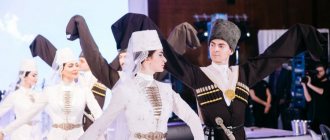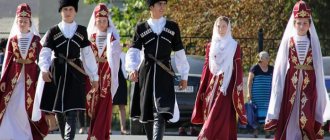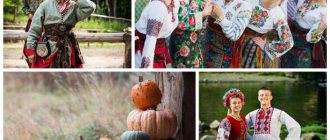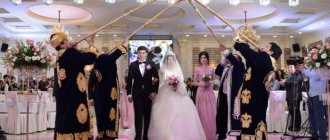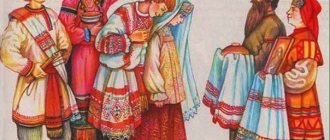A wedding in Bashkiria is considered one of those rituals that has remained virtually unchanged to the present day. However, some traditions have become obsolete in cities, but are still observed in villages.
There was a ritual in the country in which the decision to marry children was made by the parents alone. Moreover, often the couple could not even see each other in the days before the ceremony. The marriage ceremony took place at home with the participation of an invited mullah. But before, the ceremony, if desired, could be held in mosques.
Wedding traditions in Bashkiria
Often relatives thought about the ceremony at a time when the children were not even 5 years old. The engagement ceremony of young people was considered traditional; in Bashkir it sounds like “syrgatuy”. As the time for the wedding ceremony approached, the family began to carefully prepare for it: collecting a dowry, preparing jewelry, and so on. There are several key stages in the Bashkortostan wedding ceremony:
- conducting negotiations and setting the terms and conditions of marriage (collusion and matchmaking);
- Nikah or the wedding ceremony itself;
- traditions and rituals after the wedding.
The traditions of the Bashkir wedding have undergone many changes, but in small settlements they are observed today almost unchanged.
Traditions associated with the ban
There are a number of mandatory rules that a given people should follow - this is due to history. The most popular and important of them:
- in winter it is strictly forbidden to work on the land, because this period is considered a time of rest;
- any activity, including cooking and serving treats to the table, is performed only with the right hand, since it is “clean”;
- a similar rule applies when entering a mosque - only with your right foot, and at the exit you can step with your left and it is not allowed to bring small children with you to prayer;
- women are not recommended to be in mosques or even pray at home; coming to the cemetery is also strictly prohibited;
- there should not be a single gram of alcohol in food, and a ban is also imposed on pork;
- An important and testing period for every Bashkir is fasting, during which the entire daylight hours are prohibited from eating and drinking. An exception applies to people who are in a sick condition during this period, and children.
Stage of parents' agreement about the wedding
According to Bashkir traditions, the father of the future bride, after talking with his wife, went to the groom and asked his opinion about a possible wedding. The head of the family chose a bride for his son. The mother's participation in the process was limited to observing indirect formalities. After the couple was formed, the girl's father went to her father-in-law and talked about the future ceremony. After receiving consent for the wedding from the bride's father, the topic of bride price came up.
As a sign of confirmation of the conclusion of the marriage agreement, both families had to drink from the same container of kumiss or honey. This was a responsible step, since after it the parents did not have the right to marry off the bride to someone else, even if the decision to marry was hasty and the partner turned out to be unsuitable. This situation could arise, for example, due to the deterioration of the financial condition of the groom’s family. If a decision was made to cancel the wedding, a ransom was provided either in the form of a material part or a share of livestock.
What is prepared for the bride at a traditional Bashkir wedding?
Now let's take a closer look at the main rituals, especially since some of them are not without romance. The treats served at Bashkir weddings also deserve special attention.
Treat with honey
The Bashkirs are a responsible people, and if they have given their word, they will certainly keep it. At least in those matters that relate to wedding arrangements. So, according to tradition, if during an agreement on the union of young people the parents drink honey or kumiss, this will mean that the matter is decided and there is no turning back.
That is, oral agreements are stronger than a wax seal.
It is customary to treat young people with honey, but only during the wedding itself. For this, the groom's mother served honey and butter in bowls, arranging a very beautiful ceremony with meaning. The latter boiled down to the fact that after such a treat, the life of the young should become sweet like honey, going like clockwork.
The second interpretation of the custom comes down to the fact that after drinking a honey-oil mixture, the young woman’s speech should become honey-like, and her character should become soft and pliable, like oil in the sun. In general, be that as it may, this custom is far from the worst, and even vice versa.
Kalym and gifts to the bride's family
It is a misconception to think that Bashkirs are in no hurry to get married because of the unaffordable bride price, since the amount of tribute for the bride is determined individually, depending on the wealth of the groom’s family. Only the following requirements are considered mandatory:
- high-quality fox fur coat for the future mother-in-law;
- two horses: one for the father-in-law, the second for slaughter for the wedding feast.
In addition, even during the time of the Union, it was customary to pay a ransom in the amount of 15 rubles, which, in principle, was quite a reasonable amount for the vast majority of Bashkirs. Today, the size of this amount is usually determined on an individual basis.
The same can be said about other types of tribute: clothing, household gifts, livestock and other gifts that may be useful for the young. So, if the wooing parents have such an opportunity, then everything listed above can be given as a gift, as was customary in the old days. No - that means you can get by with the obligatory bride price - no one will judge, the main thing is to discuss this issue with the bride’s parents in advance.
Kalym: traditions of negotiations
Kalym was determined by the financial condition of both families. Traditionally, it included money, clothing, livestock and other collections of useful items. With the exception of horses, all other gifts were intended for the bride. One of the horses was intended for her father, and the second for dinner at the wedding celebration.
A fox fur coat was often intended for the mother as a ransom. Despite the fact that families themselves set the size of the dowry, there were mandatory points that no one could cancel, and failure to comply with them was considered a sign of disrespect for one of the parties. These points included:
- for the mother a good quality fox fur coat;
- for the father, a horse suitable for farming;
- a second horse for the wedding treat.
They also left a maximum of 15 rubles for additional expenses, which by those standards was an adequate amount.
Celebration
The Bashkir celebration traditionally began with a small wedding, to which older relatives were invited, who met at the time of matchmaking. The ceremony itself took place in the bride's house.
The ritual process was conducted by a mullah; he asked the bride's father a question regarding whether he agreed to give his daughter in marriage. Having received a positive answer, the mullah read lines from the Koran and registered the marriage in his birth register.
Only after this process could the groom enter the house of his bride and be called her husband. After all the rites and rituals were completed, the most important celebration began - the Tui festival. Wealthier families celebrated this event on a grand scale, held races, games, and treated guests to various national dishes.
But in the absence of a luxurious feast, everyone was understanding of the modest celebration and rejoiced at the wedding.
The fun continued for 3 days. After the Tui celebration, the girl had to leave her home and move to her husband's house.
But according to Bashkir traditions, this process required special efforts from the groom and his relatives. The female relatives of the bride did their best to prevent the bride’s departure by performing various “pranks.”
According to ancient custom, the girl's bed was tied into a bundle and carried into the forest. She was tied with ropes, the ends of which were hidden under the roots of trees. The bride herself was seated on an unmade bed, and after that an active “struggle” for the girl began between the relatives of the bride and groom. Despite the fact that this process was quite fun, it brought some costs to the family, since the clothes were spoiled.
Before the departure of her already established wife, she had to say goodbye to her relatives.
At the same time, the girl entered each house in the company of four friends, who held a scarf over her head.
The young wife gave each of her close relatives a tablecloth, a towel and threads
. As a token of gratitude, the girls gave money. At the end of this ceremony, the young bride put on her best attire and sat in a cart, on which she went to the groom’s house.
According to tradition, the process of seating a young wife in a cart must be accompanied by resistance on the part of the girl. She could only obediently agree after receiving a gift from her father and brothers. Before crossing the threshold of the groom's house, the girl had to kneel three times in front of her husband's parents.
In turn, the fathers-in-law, as a sign of respect and approval, each time raised the young woman from her knees. This was followed by an exchange of gifts. Guests prepare congratulations in the Tatar language.
Visit to the bride's home
2 days before the groom visits the bride for the first time, her father officially convenes relatives and tells them about the upcoming wedding. During the visit, the mullah formally marries at home. The father on the groom's side must bring a horse with him to the first visit, intended for the table. It is later traditionally stabbed to death. All guests who were invited to the celebration remained in the bride's house. First, the visitors were treated to a traditional dish called bishbarmak, after which the process of giving gifts to the newlywed guests began.
Usually the guests arrived overnight and, since there were many of them, they were distributed by the village elders to the houses of the relatives of the bride’s village. Traditionally, on the next day of the celebration, the brought horse was injected. The role of the men in the process is clear, and the task of the ladies was to check the fat content of the horse meat. Those gathered, aware of the tradition, usually preferred to wear traditional, simple clothes. When the guests arrived at the appointed place, the matchmakers usually attacked them and a traditional wedding brawl began, which sometimes lasted until the morning.
How does matchmaking and engagement work?
After the decision to choose a bride was made by the father, he went to the future father-in-law and negotiated with him about the upcoming wedding.
If the girl’s father gave his consent, then the next stage included negotiations on the bride price. The main role in Bashkir matchmaking belongs to the father of the groom, since it is he who chooses the bride for his son. The role of the mother in this matter is secondary.
The father, taking with him his closest relatives, set off to woo the young girl. Of course, the other party already knew that special guests were coming to them and carefully prepared for their arrival.
The matchmakers' reception is very solemn, with a variety of treats placed on the tables.
The atmosphere of matchmaking has a festive mood, both parties communicate, while inclining the conversation to jokes in order to make the process friendlier.
By the end of the feast, those present smoothly shift the topic of conversation directly to the main event, thanks to which the guests arrived.
The main thing that is negotiated is the bride price (ransom) and the wedding process itself, in which senior relatives and close friends of the bride’s family will take part. As a sign of the decision to marry their children, parents drank honey from the same cup. After such a tradition, the bride's parents could no longer consider anyone else as a groom for their daughter.
If for some reason the contract had to be broken, the girl's father had to pay money to the failed matchmakers or pay with livestock.
Visiting the father-in-law and mother-in-law at the groom's house
After the guests have stayed with the matchmakers for a couple of days, they usually go back to their homes. After which the mother-in-law and father-in-law go to the groom's father. A special women's and men's room was prepared for their arrival. The bride's mother had to bring with her a chest containing gifts and national clothes.
After the dinner ceremony, the men went to the ladies' room. There, the bride's mother invited someone to open the chest, and gave the girl who agreed a scarf. The threads were given to old women, who were supposed to accept them with prayers, but were not obliged to give gifts in return. The shirt was intended for the bride's father in exchange for cattle for the young family. After the ceremony of exchanging gifts, the guests traditionally left for their homes.
What holidays do Bashkirs celebrate?
The customs and traditions of the Bashkirs are clearly reflected in the holidays. They can be roughly divided into:
- State - New Year, Defender of the Fatherland Day, Flag Day, Ufa City Day, Republic Day, Constitution Adoption Day.
- Religious - Uraza Bayram (the holiday of the end of fasting in Ramadan); Kurban Bayram (festival of sacrifice); Mawlid an Nabi (birthday of the Prophet Muhammad).
- National - Yiynyn, Kargatuy, Sabantuy, Kyakuk Syaye.
State and religious holidays are celebrated almost equally throughout the country, and there are practically no traditions and rituals of the Bashkirs. In contrast, national ones fully reflect the culture of the nation.
Sabantuy, or Habantuy, was celebrated after sowing from about the end of May to the end of June. Long before the holiday, a group of young people went from house to house and collected prizes and decorated the square - the Maidan, where all the festive events were supposed to take place. The most valuable prize was considered to be a towel made by a young daughter-in-law, since the woman was a symbol of the renewal of the family, and the holiday was dedicated to the renewal of the earth. On the day of Sabantuy, a pole was installed in the center of the Maidan, which was oiled on the day of the holiday, and an embroidered towel fluttered on top, which was considered a prize, and only the most dexterous could climb up to it and take it. There were many different types of entertainment on Sabantuy - wrestling with bags of hay or wool on a log, running with an egg in a spoon or bags, but the main ones were horse racing and wrestling - kuresh, in which rivals tried to knock down or pull the opponent with a towel wrapped around them. The aksakals watched over the fighters, and the winner—the hero—received a slaughtered ram. After the fight, they sang songs and danced on the Maidan.
Kargatuy, or Karga Butkahy, is a holiday of the awakening of nature, which had different scenarios depending on the geographical location. But cooking millet porridge can be considered a common tradition. It was held in nature and was accompanied not only by a collective meal, but also by feeding the birds. This pagan holiday existed even before Islam - the Bashkirs turned to the gods with a request for rain. Kargatuy also could not do without dancing, singing and sports competitions.
Kyakuk Saye was a women's holiday and also had pagan roots. It was celebrated near a river or on a mountain. It was celebrated from May to July. Women with treats walked to the place of celebration, each made a wish and listened to the bird cooing. If it rings, then the wish was fulfilled. Various games were also played at the festival.
Yiynyn was a men's holiday, since only men took part in it. It was celebrated on the day of the summer equinox after a public meeting at which important issues regarding village affairs were decided. The council ended with a holiday, for which they had prepared in advance. Later it became a common holiday in which both men and women participated.
Small Wedding Rite
Traditionally, the wedding ceremony in Bashkiria took place at the house of the bride’s father. Those old people who had previously taken part in the matchmaking ceremony also gathered here. The task of the arriving mullah was to ask the consent of the bride's father for the wedding. If the answer was positive, the mullah read a certain part of the Koran, after which he entered the marriage contract into the so-called metric register. For such an action, the mullah was entitled to compensation of 1% of the total amount of the dowry. After the ceremony, the groom had the right to visit his wife’s house whenever he wanted in the role of a husband.
What is the Tui festival?
After the entire dowry was paid, the husband came to his father-in-law for his bride or already legal wife. The father-in-law was obliged to prepare in advance for the visit and organize a holiday called Tui. A wedding in Bashkiria allowed even low-income families to start a family. In this case, instead of the Tui holiday, a small modest treat was arranged. The festival ceremony usually lasted from 1 to 3 days. If the family’s finances allowed, then they could not do without holding various public events such as horse racing and wrestling.
Ceremony of fighting for the bride
This ritual is somewhat similar to competitions for modern young people and consisted in the fact that guests using various methods prevented the bride from leaving her home. The obstacles depended on the imagination of those gathered and the newlyweds themselves: they could either create obstacles or even tie the bride to a pole. Damage caused by the fight was usually paid for by the groom. After the groom’s victory and additional gifts to the bride as compensation for possible moral damage, she was nevertheless taken to the groom’s new home.
Two days before the small wedding
Before the religious wedding, when the mullah will marry, the girl’s parents receive guests. The head of the family invites up to twenty guests from among his relatives to his home and informs them about the arrival of the matchmakers. After the father receives the consent of his relatives to organize the holiday, the bride's parents invite the groom's family to their home. In order to convey the invitation, a messenger is sent to the groom's house, returning back with a horse, which will later be slaughtered.
Relatives from the boyfriend's side arrived and brought many gifts for their potential relatives. After dinner, everyone went to rest, and in the morning preparations for the wedding began. Having changed their clothes so as not to stain their festive attire, both families slaughtered the donated horse. In the customs of the Bashkirs, there is a tradition of staging a comic brawl while butchering an animal.
Bride moving to a new family
Before the final departure, the young people had to say goodbye to their relatives by visiting all the houses in the village. According to tradition, the girl was surrounded by 4 friends, who were supposed to cry and raise a symbolic scarf over the bride’s head. Female relatives were presented with unique gifts such as tablecloths or scarves. In response, the ladies gave the intended girl money and other material assets. After visiting all the houses, the bride was usually put in a cart and before that dressed in her best costumes. According to tradition, the girl had to resist until her father or brother gave her a gift or a kind of ransom.
Another tradition provided for the bride to be accompanied by a relative, who was supposed to receive a ransom for her from the groom's father. After arriving at the new house, the bride knelt 3 times in front of the groom's family, and after each time they raised her. After the ritual, the traditional exchange of gifts took place.
What dishes are national?
Bashkir national cuisine was formed under the influence of wintering in villages and a nomadic lifestyle in the summer. Distinctive features are a large amount of meat and the absence of a large number of spices.
The nomadic lifestyle led to the emergence of a large number of long-term storage dishes - horse meat and lamb in boiled, dried and dried form, dried berries and cereals, honey and fermented milk products - horse sausage (kazy), fermented milk drink made from mare's milk (kumys), bird cherry oil (muyil mayy).
Traditional dishes include beshbarmak (meat and large noodle soup), vak-belish (meat and potato pies), tukmas (goose meat soup with thin noodles), tutyrlgan tauk (stuffed chicken), kuyrylgan (potato salad, fish, pickles, mayonnaise and herbs, wrapped in an omelette).
Bashkir culture today is a reflection of the historical path of the people, which as a result has absorbed only the best.
Post-wedding rituals
The next day, the family could send the bride with rockers to fetch water. She usually took with her a silver coin, which was tied on a thread. This symbol was considered a sacrifice of a young wife to a water spirit. But the children sometimes tried to catch the coin. In any case, after the girl threw her into the water, it was believed that she could walk to any body of water without hindrance.
How did you settle in your spouse’s house?
After the Tui holiday, there were their own traditions and customs, which were mentioned earlier, but they are worth summarizing. So, the tradition included:
- the bride kneeling three times in front of the new family, followed by her relatives lifting her up;
- mutual exchange of gifts with the bride;
- visiting a river or pond with a special talisman for safety from water spirits.
The tradition also included the initial revelation of the bride’s face to her husband after the previous rituals were performed.
The process of changing status from bride to wife also occurred with certain traditions:
- a girl's hairstyle was changed from one braid to two;
- replacing a girl's headdress with a woman's one. By the way, the girl’s one is called Takiyya, and the women’s one is popularly called Kashmau;
- tying a belt as a symbol of happiness, good luck and family well-being.
But not only the bride had certain rituals for changing social status. A man also had a number of customs, the observance of which was mandatory in order to be recognized as a full-fledged husband. Here they are:
- obtaining consent to marriage;
- secret adventures with the bride;
- entry into adult family life.
The rituals were also accompanied by additional training for the young couple in the wisdom of adult life from the older generation.
Pre-wedding chores
So, the wedding rituals of the Tatars can be divided into three main actions: pre-wedding, the wedding itself and post-wedding.
Pre-wedding events include matchmaking, which is consent to marriage and stipulation of the conditions for its conclusion. The groom's relatives were most often sent as matchmakers. However, as K. Nasyri noted, “it also happens that the bride’s parents themselves send matchmakers to the groom’s house, who hint that if they asked for their daughter, they would not be refused.”
In a Tatar house. Photo zidanio.livejournal.com
The matchmakers not only had to speak well when talking about the applicant, but they also had to have peculiarities in their clothing. So for the matchmaker, one pant leg rolled up above the knee, and for the matchmaker it extended over the top of the boot.
After the first visit to the matchmakers, and they could come five or six times before receiving an answer, the parents gathered close relatives for advice. During each of the matchmakers’ visits, they negotiated about what would be given as a gift from the groom (kalyn
) and in what quantity. Outer and underwear, hats, and shoes were used as gifts. Moreover, feather beds were an obligatory part. Often, the kalyn included livestock - a horse, cow, sheep, poultry, etc. In addition, before the wedding, the groom had to pay the agreed amount of money (which was usually used by the bride’s parents to prepare a dowry, gifts), and also bring a certain quantity of products - meat, butter, milk, honey, tea. According to K.F. Fuchs, kalyn could amount “to rich Tatars in Kazan from three to five thousand rubles, depending on the condition of the bride and groom. In villages, the wealthy have from two hundred to five hundred rubles, the poor from fifty to one hundred rubles.”
Upon reaching mutual agreement between the parties, the bride's parents invited both the groom's parents and the matchmakers to the engagement agreement, where the parties exchanged gifts as a sign of the final agreement. Upon returning to the house, the groom's parents arranged a festive meal, during which everyone was informed about the bride's consent, the timing of the wedding, the guests and their possible assistance in preparing the ransom. The gifts received were displayed to the guests, and all those present allocated a small amount of money for the bride.
After the engagement agreement, meetings were held between future relatives with a mutual exchange of gifts and refreshments to introduce them to each other. During this pre-wedding time, there was a ritual of viewing the bride. It could have slightly different variations, but the basis was the same, when the groom’s mother and his relative met their daughter-in-law. So, for example, in some areas (based on materials from R.K. Urazmanova), the groom’s mother had to recognize “her” among other young girls covered with a scarf/shawl. Afterwards mutual gifting took place. A bachelorette party with wedding refreshments was also held at the bride's house.
After the treat, the groom left a gift for the bride, sitting in another room or behind a curtain. Photo aif.ru
Not only relatives, but also friends gathered for the bachelor party, held at the groom's house. The groom gave the guests small gifts and received money in return. On the night before the wedding, a “night wedding” could be held, when the groom and friends were invited to an evening tea party at the bride’s house. After the treat, the groom left a gift for the bride, sitting in another room or behind a curtain.
Thus, the pre-wedding ritual part included repeated visits to the newlyweds' relatives to meet each other, exchange gifts and assist in preparing the wedding.
About the wedding ceremony itself (nikah) and post-wedding traditions - continued
Dina Gatina-Shafikova
Reference
Dina Gatina-Shafikova is a research fellow at the Department of Ethnological Research at the Institute of History. Sh. Marjani AN RT.
- In 2010 she graduated from the Faculty of History, Department of Archeology at the Kazan (Volga Region) Federal University.
- In 2014, she completed her postgraduate studies at the Institute of History. Sh. Marjani AN RT.
- From 2010 to 2013, employee of the National Museum of the Republic of Tatarstan.
- Research interests: visual anthropology, Tatar costume, history of the Volga-Ural Tatars.
- Author of a number of popular science and research publications. Columnist of Realnoe Vremya.
Traditional marriage prohibitions
The main ban in Bashkiria was that a man could marry a woman of his own kind. Kinship was considered between relatives of 4 generations. Relatives in the fifth and sixth generations could marry, in other words, tyua ayat and ete ayat. The girl's marriageable age was 14-15 years old; ideally, the husband should be at least 3 years older than her.
Until the 20th century, levirate was considered the rule of law in Bashkiria. This is a form of marriage in which a widow could marry the brother of the deceased if she wished. Any other relative of the deceased could also give money to the widow. Not only the children and property of the deceased, but also his entire social position and fortune passed to the widow’s new husband. This system contributed to less labor drain, for example, within wealthy dynasties and families.
Collusion
In the old days, the decision to marry rightfully belonged to the parents of young people. As a sign that the agreement had taken place, the parents of the boy and girl who were matched together drank from the same kumiss from the same vessel. From that very moment the girl was considered a bride; she could no longer be married to someone else. If, after some time, the girl’s father changed his mind, he had to give a ransom: livestock or money. This continued until the twentieth century, after which the conspiracy gradually began to fade away.
We got married very early at that time. On average, the age of marriage for boys was 15-16 years, for girls - 13-14 years. As soon as the father decided that it was time to marry his son, he asked his wife for advice. He did not forget to ask his son for opinions. The father usually chose the bride for his child, although he consulted with his wife. But the last word still belonged to him.
National wedding clothes in Bashkiria
They prepared very carefully for the marriage ceremony in the country. Usually, special suits were sewn for young people, which after the celebration they could wear to important events. Traditional dresses were full of bright flowers and satin ribbons. Some regions still decorate bridesmaid dresses using the so-called chain stitch. Over the main outfit, komzols and special national robes were worn.
An important ritual was the fitting of a woman's suit for the bride and a change of clothes. The ceremony was carried out before the lamentations of the young girl, after which her groom took her to his house.
The bride's headdress was of particular national significance. Sometimes, right at the wedding, the girl took off the bride’s headdress and put on the female version, becoming an adult woman.
In the South-Eastern regions of the country, the young woman’s head was covered with a scarf and a silver kashmau, which was shaped like a helmet, was put on. It also often included corals. In a number of other localities, the role of national headdress was given to a simpler cap, which was embroidered using beads and intricate patterns.
For the people of Bashkiria, items of clothing were not only a household necessity, but also gifts, as well as amulets from the forces of evil. A Bashkir wedding required that the bride before the ceremony should bring her husband a shirt, collar and sleeves, as well as a skullcap and handmade trousers. Colors also had a special meaning and vibrant variations of red, green and blue were used for the wedding. The grooms girded themselves with a sash, and for the bride a belt was sewn from bright woven scraps.
Bridal clothes
The national colorful costume plays an important role during the wedding ceremony. However, the bride’s wedding dress, which is a product quite complex in texture, also receives no less attention. The groom always wears a red sash to the wedding, and the bride wears a multi-colored belt.
One of the rituals of a Bashkir wedding is the transformation of the young woman into a wife. For this purpose, the wedding headdress is replaced with a symbolic female one, which gives the bride the right to cross the threshold of her lover’s house.
Source
Parental blessing
Blessing the newlyweds for family life is one of the most important stages of an ancient wedding. In the old days, it was unthinkable to get married without the approval of older relatives. It was believed that without parental approval, young people would not see happiness and prosperity in family life. The blessing was given by the parents of the young, or their godparents, and in case of their absence or death, by the most respected senior relatives and guardians. The ritual is divided into two stages.
First blessing
The newlyweds receive it from the bride's parents on the morning of the wedding day. That is, immediately before visiting the registry office or the sacrament of wedding in the church. In the old days, this ritual was performed long before the wedding, on the day when the groom’s matchmakers received the consent of the bride’s parents for the marriage. But today the tradition of matchmaking is practically no longer used. How does the ritual work?
The young people ask for a blessing from the bride's parents after the groom has paid the ransom for his beloved, passed all the tests that the relatives and bridesmaids could think of, and handed her a bouquet. During the entire ceremony, the girl is forbidden to cross the threshold of the house or go outside. It is believed that beyond the threshold the bride no longer belongs to her family, she begins a new life. They bless in different ways. An ancient custom dictates that an embroidered towel should be laid out, on which the newlyweds kneel.
And the parents are holding in their hands an old, prayed-up icon, with which they baptize the newlyweds, saying kind parting words. Today you can get by with just good wishes and mutual hugs: parental approval is very important for children, even if they are already quite adults.
By blessing, the parents fully accept their daughter’s chosen one into their family and approve of her choice.
Second blessing
It is given to the young family by the groom's parents. According to established traditions, newlyweds must acquire the official status of a new family by going through the marriage procedure at the registry office, or by getting married in a temple (depending on national and family traditions). Previously, the ritual was performed on the threshold of the groom's house, where he brought his young wife. The action itself almost completely copied the morning blessing, except that the parents chose their own words. Today it is permissible to hold a ceremony at the site of the festive feast - in front of the entrance to a banquet hall, bar or cafe, in a forest clearing or on the shore of the sea, lake, or on board a ship.
Newlyweds who do not want to follow the old canons can include blessing ceremonies in the banquet script. Under the guise of one of the first toasts, parents will talk about the wonderful qualities of their children entering a new life, wishing love and harmony in family relationships, prosperity and prosperity. You can arrange the blessing in poetic form or even put on a small performance, showing children's photos and videos, the story of the newlyweds' acquaintance and love.
What does the veil symbolize?
Today's light, almost weightless, veil is a modified veil that was used to cover brides from head to toe. In Ancient Rome and Greece, people covered themselves completely in a veil, with the exception of the face. According to historians, it was bright yellow and was intended to scare away evil spirits. Some believe that such an inconvenient addition to the festive outfit served as a serious obstacle to the girl’s escape from the aisle.
Russian traditions at a wedding required that girls in a wedding dress be wrapped in heavy, opaque pieces of fabric with elegant embroidery. This procedure symbolized the death of the bride for her family, and the ritual of removing the veil in the groom’s house revived her for a new family.
In the East, a veil was not placed on the bride's head. A weightless, translucent piece of silk was kept between the young couple so that they could not touch each other until the moment of privacy in the bedroom.
Modern wedding customs are quite democratic. If fifty years ago a girl did not dare to wear a veil to a wedding, if she was not innocent, then today everything depends only on the tastes and preferences of the bride. You can decorate your outfit with a luxurious, long veil, a lace cape-mantilla in the Spanish style, or limit yourself to a modest veil attached to a flirty hat or headpiece. Or you can do without this attribute of an old wedding altogether. Often, instead of a veil, brides prefer to decorate their hair with a magnificent tiara, a wreath of fresh flowers, a hair net, beads and chains, and jewelry.
Historical and national features of the Tatar wedding
Rich national traditions make a Tatar wedding interesting, original, and has retained its innermost zest. Previously, weddings were celebrated in November, after agricultural work was completed.
The basic Islamic canons are strict and laconic. In the old days, parents of young people themselves decided the fate of their children. The choice, agreements, and organization of the wedding itself were carried out by the parents with the help of matchmakers. The young people were only notified of the decision. Wedding celebrations were held separately for men and separately for women.
Strict Muslim laws require young people to behave modestly at the celebration, without showing feelings. The bride is not allowed to talk, drink or eat. In some places, she was not even present at the festive table, but was waiting for the groom in a specially decorated room. After the wedding, the young wife was not allowed to leave the house for forty days.
National wedding features contain many bright, mysterious rituals:
- Matchmaking. Engagement. Collusion. Parents meet, get acquainted and discuss terms. At the same time, gifts are exchanged. The newlyweds may not be present at the matchmaking ceremony.
- Kalym. This is a bride price; the number of gifts is agreed upon jointly by the parents. The ransom included household items, furniture and household items, dresses, scarves, and money. Traditionally, the bride ransom is performed in the Tatar language.
- Kiyallipier. Comic tests that bridesmaids prepare for the groom. They are always fun and funny, but they require from the groom not only skill and strength, but also material resources.
- Nikah. A religious ceremony confirming a Muslim marriage in accordance with Sharia law, performed by a mullah. Consists of reading the Koran, prayers, spiritual instructions. Only Muslims dressed in national dresses and with their heads covered are invited, although the bride and groom may not be present at this main ceremony. But before the nikah, the young people should not be left alone.
- Tui. This is actually the Tatar wedding itself, which lasts several days in different houses. First, they go for a walk with the bride's parents and relatives, and then the groom takes the bride to his parents' house. Here they greet her hospitably and warmly, presenting her with rich gifts. A special sign of the bride’s warm welcome is the soft pillows that are placed under her feet. Another interesting ritual is associated with wishes for wealth, to become a good housewife - the bride’s hands are dipped in flour. The scenario for such festivities is usually typical.
All ceremonial wedding ceremonies are beautiful, unforgettable and colorful. Before the wedding, in both houses of the parents of the bride and groom, a mysterious ritual ceremony was held to commemorate the souls of deceased relatives. This is how a blessing for marriage was asked. Respect for elders was also expressed in the fact that, according to ancient tradition, wedding feasts are organized according to the ages of the guests, then more than one scenario is prepared.
